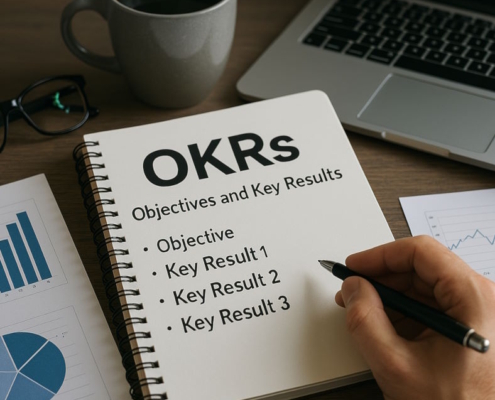1. Introduction to Business Profit
Understanding how to calculate profit is crucial for any business owner. Profitability is not just an indicator of business success; it’s essential for survival. (Article 7) Profit equals the total amount of money made minus all expenses, including operational and tax-related costs. What is profit if not the most critical measure of a business’s financial health, showing the surplus after expenses?
Example: A bakery generates $10,000 in monthly revenue. After deducting $6,000 in operational costs, including rent, supplies, and labor, the bakery’s profit is $4,000. This reflects the formula: Profit = Total Revenue – Total Expenses.
2. Components of Business Profit
Revenue
Revenue is the total income collected from normal business activities, typically sales of goods and services. It reflects the ability of a business to generate sales, forming the foundation of financial performance.
To calculate total revenue, multiply the price of each product by the number of units sold and sum up the results. (Article 1) The revenue formula, Revenue = Price × Quantity, provides a clear snapshot of sales performance over a given period. This metric helps businesses understand their financial progress and set strategic objectives.
Example: If a boutique sells 200 dresses at $50 each, the total revenue is $10,000. The revenue equation applies here: Revenue = Price × Quantity.
Revenue is often referred to as the “top line” because it represents the starting point of an income statement. It provides a snapshot of a company’s sales performance and market demand. High revenue signals strong demand, but without effective cost management, it may not translate into profitability.
Expenses
Expenses are the cost of resources used up or consumed by the activities of the business. These costs are classified into fixed expenses, such as rent and salaries, and variable expenses, including raw materials and production supplies. (Article 2)
Profit equals the total amount of money made minus these costs, indicating that effective expense management is crucial for achieving profitability. (Article 2) A business must continuously analyze its expense structure to identify inefficiencies and reduce costs without compromising quality.
Example: A coffee shop spends $2,000 on rent, $3,000 on supplies, and $4,000 on staff salaries each month, totaling $9,000 in expenses.
Expenses also play a key role in determining net profit. The profit formula, Profit = Revenue – Expenses, highlights how every dollar spent impacts the bottom line. This encourages businesses to streamline operations and control overhead costs for better financial health.
Taxes
Taxes are another essential consideration in business profitability. They represent a significant portion of deductions from operating profit to arrive at net profit. Taxes must be carefully calculated to avoid penalties and ensure compliance with government regulations.
Businesses often use the net profit formula to include taxes in their financial calculations: Net Profit = Revenue – (COGS + Operating Expenses + Taxes + Interest). This ensures accurate accounting and financial planning.
Example: If a business makes $50,000 in profit and owes $10,000 in taxes, the remaining profit after taxes is $40,000.
Taxes can affect the overall cash flow and require strategic planning to optimize deductions and credits. Businesses work with tax advisors to ensure they leverage all possible benefits and maintain compliance while minimizing their tax burden.
Depreciation
Depreciation is a non-cash expense that reduces the value of an asset as a result of wear and tear, age, or obsolescence. It’s a crucial factor in calculating operating profit and net profit, as it reflects the declining value of assets used in business operations.
Depreciation is calculated annually and included in the company’s income statement. This non-cash expense lowers taxable income, providing tax benefits while accurately reflecting the financial health of the business. It also ensures that asset values on the balance sheet remain realistic over time. (Article 3)
Example: A delivery company has a van worth $50,000 with a useful life of 5 years. Each year, $10,000 is accounted as depreciation.
Including depreciation in the profit equation ensures a realistic view of profitability, especially when businesses rely heavily on physical assets. By spreading the cost of an asset over its useful life, depreciation helps businesses align their expenses with revenue generation.
Interest
Interest is the cost associated with loans or credit. It’s deducted from operating profit when calculating net profit, making it a critical consideration for businesses that rely on external financing. Interest reflects the cost of borrowing and directly impacts financial performance.
For businesses with significant debt, interest expenses can erode profitability if not managed effectively. Companies often track interest costs using the net profit formula, which includes interest as a key deduction from operating profit.
Example: A company pays $2,000 annually as interest on a $50,000 loan taken to purchase machinery.
Interest costs should be minimized by negotiating favorable loan terms and refinancing when possible. Effective debt management ensures that businesses maintain strong financial health while leveraging borrowed funds for growth and expansion.
3. Types of Profit
Gross Profit
Gross profit represents the direct profit associated with the production and selling of goods or services, calculated before deducting overhead, payroll, taxation, and interest payments. It allows businesses to ensure their direct costs of selling goods or services do not exceed their revenue.
How is gross profit calculated? Subtract the cost of goods sold (COGS) from total revenue using the gross profit equation. Gross profit highlights earnings before operational expenses, helping businesses focus on direct profitability.
Example: A bakery sells goods worth $10,000. The COGS, including flour, sugar, and packaging, totals $4,000. The gross profit is $10,000 – $4,000 = $6,000.
Calculating gross profit helps identify areas where margins are slipping and informs decisions related to cost management, supplier negotiations, or pricing strategies. For instance, businesses may review their inventory costs or adjust pricing to improve their gross profit percentage formula.
Gross profit is a critical metric for determining production efficiency and identifying potential cost increases. By evaluating the direct profitability of goods, businesses can make informed adjustments to optimize their financial performance.
Operating Profit
Operating profit measures the earnings generated from core business operations after subtracting operating expenses. It starts with your total gross profit, then deducts costs associated with the day-to-day running of the business, such as rent, utilities, and marketing.
Operating profit is sometimes referred to as EBIT, which reflects the operational efficiency of a company without the influence of tax or debt obligations. It’s an essential measure for investors and creditors to assess a business’s ability to generate consistent income.
Example: Using the bakery example above, if the operating expenses, including rent and utilities, are $3,000, the operating profit is $6,000 – $3,000 = $3,000.
Analysts often scrutinize operating profit when exploring cost-cutting opportunities. Since operating expenses are typically easier to control than COGS, they present a target-rich environment for potential savings. A rising operating profit indicates robust operational performance, which is a key metric for investors and lenders.
Net Profit
Net profit is the final indicator of profitability and is often referred to as the bottom line. It takes into account all revenues and expenses, including taxes and interest, to measure the overall profit or loss for a financial period. Net profit provides a comprehensive picture of a company’s financial health and its ability to generate surplus funds after covering all costs.
To calculate net profit, subtract all expenses, including taxes and interest, from gross profit. This figure reflects the actual earnings available for reinvestment, dividends, or savings. Businesses use the net profit formula to evaluate their overall profitability.
Example: If the bakery’s taxes are $500 and loan interest is $200, the net profit is $3,000 – $500 – $200 = $2,300.
Net profit is critical for assessing whether a business is viable in the long term. It’s also an essential measure for stakeholders, as it indicates the earnings that can be distributed to owners or reinvested in business opportunities like new product development or equipment purchases. For example, net profit can help businesses determine their profit percentage formula, which benchmarks profitability against industry standards.
Understanding and calculating these types of profit—gross, operating, and net—is fundamental for evaluating a business’s financial health and operational efficiency. Each type of profit provides unique insights into different aspects of the company’s performance, enabling informed decision-making and strategic planning.
4. Step-by-Step Calculation of Profit
Step 1: Determine Total Revenue
Revenue is the first step in calculating profit. It represents the total income generated from sales and other sources before any deductions. To calculate revenue, use the formula for revenue: Total Revenue = Selling Price × Quantity Sold. This formula gives businesses a clear snapshot of their gross earnings from sales activities.
Example: A florist sells 100 bouquets for $20 each, resulting in total revenue of $2,000.
Revenue provides the foundation for all profit calculations, offering a snapshot of the business’s sales performance. A higher revenue indicates strong market demand, but it’s not a direct reflection of profitability until costs are considered.
Step 2: Calculate the Cost of Goods Sold (COGS)
The cost of goods sold (COGS) includes direct costs associated with producing goods or services. This can include raw materials, labor, and any other expenses directly tied to the production process. Including these costs is essential in the gross profit calculation.
Example: The florist spends $800 on flowers and wrapping supplies. COGS = $800.
COGS reflects the efficiency of a business in managing production costs. Lower COGS relative to revenue can lead to higher gross profit, which is a vital measure of direct profitability.
Step 3: Subtract COGS from Revenue
Once COGS is determined, subtract it from total revenue to calculate gross profit. Gross profit is the income remaining after accounting for the direct costs of production. The gross profit percentage formula, Gross Profit % = (Gross Profit ÷ Total Revenue) × 100, provides insights into how efficiently a business generates profit from its sales.
Example: Gross Profit = $2,000 – $800 = $1,200. Gross Profit % = ($1,200 ÷ $2,000) × 100 = 60%.
Gross profit measures the profitability of core business operations without considering overhead and other operating expenses. A high gross profit percentage indicates strong product pricing and cost management.
Step 4: Deduct Operating Expenses
Operating expenses include costs necessary to run the day-to-day operations of a business, such as rent, utilities, marketing, and salaries. Deducting these expenses from gross profit calculates the operating profit, a key indicator of a company’s operational efficiency. The profitability formula, Profitability = (Net Profit ÷ Total Revenue) × 100, is often used to gauge financial health.
Example: Operating expenses for the florist total $400. Operating Profit = $1,200 – $400 = $800.
Operating profit reflects the income generated from core business activities before accounting for taxes and interest. It helps businesses identify opportunities to reduce overhead and improve operational efficiency.
Step 5: Account for Taxes and Interest
Taxes and interest are deducted to finalize the profit equation and calculate net profit. These costs reflect the financial obligations a business must fulfill before determining its bottom line. Net profit provides a clear picture of the remaining earnings available for reinvestment, savings, or distribution to shareholders.
Example: After $100 in taxes and $50 in interest, Net Profit = $800 – $100 – $50 = $650.
Net profit is a crucial measure of a business’s financial performance, as it accounts for all expenses, including taxes and interest. It provides insights into overall profitability and serves as the basis for calculating key financial metrics like profit margins.
5. Profit Margin Analysis
Understanding Profit Margin
Profit margin is a critical metric for businesses to evaluate their financial performance and compare it with industry peers. It measures the percentage of income remaining after all expenses are deducted from revenue, offering insights into how efficiently a business converts sales into profit. This metric is especially valuable for benchmarking profitability across businesses in the same industry.
To calculate profit margin, divide net profit by total revenue and multiply by 100. For detailed insights, businesses often use the gross profit rate formula to determine how effectively they manage production costs relative to their revenue.
Formula and Example
To calculate profit margin:
- Profit Margin = (Net Profit ÷ Total Revenue) × 100
Example: If a clothing retailer earns $5,000 in net profit on $20,000 in revenue, the profit margin is calculated as follows:
- Profit Margin = ($5,000 ÷ $20,000) × 100 = 25%.
This means the retailer retains 25 cents of every dollar earned as profit after accounting for all expenses.
Types of Profit Margins
Businesses analyze profit margins through three primary lenses:
- Gross Profit Margin: This focuses on the relationship between revenue and the cost of goods sold (COGS), revealing how efficiently a company produces and sells goods.
- Operating Profit Margin: This metric reflects earnings before interest and taxes, considering operating expenses like rent, utilities, and salaries. It helps evaluate operational efficiency.
- Net Profit Margin: Known as the “bottom line,” this indicates the final profitability after accounting for all expenses, taxes, and interest.
Industry Comparison
Profit margin helps businesses benchmark their financial health against competitors. Industries have varying standards for acceptable profit margins. For example, a restaurant with a 10% margin might be considered successful, while a consulting firm with the same margin could signal inefficiencies since professional services often yield higher margins.
Businesses use this comparison to identify areas of improvement, such as optimizing costs or adjusting pricing strategies. For instance, a low gross profit margin might prompt a company to renegotiate supplier contracts or switch to more cost-effective materials.
Strategic Insights
Profit margin analysis plays a crucial role in financial planning and decision-making. By tracking changes in profit margins over time, businesses can identify trends, anticipate challenges, and prepare for future opportunities. A declining gross profit margin, for example, may highlight increasing production costs or inefficiencies in the supply chain.
Example: A bakery generating $15,000 in gross profit from $30,000 in revenue calculates a gross profit margin of ($15,000 ÷ $30,000) × 100 = 50%. This analysis helps the bakery ensure its pricing strategy aligns with its profitability goals.
Improving Profit Margins
Profit margin analysis allows businesses to pinpoint inefficiencies and implement strategic changes. To improve profit margins, companies may:
- Optimize pricing strategies.
- Streamline operations to reduce overhead costs.
- Leverage technology to enhance efficiency.
- Focus on high-margin products or services.
By understanding and applying profit margin analysis, businesses can enhance their competitiveness, ensure long-term profitability, and make informed decisions that support sustainable growth.
6. Adjustments for Complex Scenarios
Non-Recurring Items
Non-recurring items, such as one-time revenues or expenses, are events that do not reflect the regular operations of a business. These items should be excluded from profit calculations to provide a clearer picture of ongoing financial performance. Ignoring this adjustment can lead to an inflated or deflated view of profitability.
Example: A company receives a $10,000 insurance payout for damages. This non-recurring income is excluded from regular profit calculations, as it does not reflect the company’s operational revenue. Including such items in profit analysis can distort financial projections and mislead stakeholders.
Businesses often adjust their profit calculations to remove these anomalies, ensuring that the reported figures align with core business activities. This approach provides a consistent and realistic representation of financial performance over time.
Seasonality Adjustments
Seasonal fluctuations can significantly impact revenue and profit, particularly for businesses operating in industries with high seasonality. To accurately analyze profitability and plan resources, businesses must account for these variations. Seasonal adjustments focus on peak months to establish reliable working capital targets and evaluate performance during critical periods.
Example: A ski resort earns $200,000 in winter months but only $50,000 during the off-season. Seasonal adjustments focus on winter as the peak period, ensuring financial strategies account for the high revenue generated during this time. This approach helps the resort manage resources effectively, such as staffing and inventory, to optimize operations during its busiest months.
For highly seasonal businesses, these adjustments are vital. Failing to account for seasonality can result in insufficient liquidity or misaligned planning, jeopardizing operations during high-demand periods.
Depreciation and Amortization
Depreciation and amortization are non-cash expenses that adjust the cost of tangible and intangible assets over their useful lives. These adjustments lower the reported net profit but provide an accurate reflection of asset value and assist in long-term financial planning.
Depreciation reduces the value of physical assets, such as machinery or vehicles, due to wear and tear or obsolescence. It is recorded annually to align asset costs with the revenue they generate.
Example: A delivery business depreciates a $50,000 vehicle over five years, recording $10,000 annually as depreciation expense. This adjustment reflects the asset’s declining value and reduces taxable income.
Amortization applies to intangible assets, spreading their cost over a defined period.
Example: A business amortizes a $25,000 software license over five years, recording $5,000 annually. This ensures the cost is allocated proportionally, aligning with the license’s contribution to operations over its duration.
Both depreciation and amortization are essential for accurate profit calculation. They ensure the business’s financial statements reflect realistic asset valuations and help in planning for future investments or replacements.
Strategic Importance of Adjustments
Adjusting for non-recurring items, seasonality, and asset costs ensures financial reports accurately represent a business’s profitability and operational performance. These adjustments are critical for making informed decisions, maintaining transparency with stakeholders, and aligning financial strategies with long-term goals. By addressing these complexities, businesses can achieve a clearer and more actionable view of their financial health.
7. Tools for Calculating Business Profit
Manual Calculations
Calculating profits manually involves using formulas like the gross profit equation, Gross Profit = Revenue – COGS, and the profit equation, Profit = Total Revenue – Total Expenses.
Example: A bookstore generates $8,000 in revenue, with $3,000 in COGS and $2,000 in expenses. Net Profit = $8,000 – $3,000 – $2,000 = $3,000.
Accounting Software
Accounting software simplifies calculations. Tools like QuickBooks use built-in functions to help businesses find metrics such as gross profit rate and net profit percentage.
Example: Using QuickBooks, a restaurant tracks $50,000 in monthly revenue and calculates a gross profit rate of 65%.
Profit Margin Calculators
Profit margin calculators are invaluable for determining net profit, gross profit, and operating profit margins.
Example: An online calculator shows a gross profit of $30,000 from $50,000 in revenue, yielding a 60% profit margin.
Decision Making
Profitability analysis plays a pivotal role in guiding key business decisions, such as pricing strategies and cost management. By leveraging the gross profit percentage formula, businesses can evaluate the impact of pricing changes on profitability. This helps them strike a balance between competitive pricing and maintaining healthy profit margins.
Example: A manufacturer increases its price from $10 to $12 per unit and observes a rise in gross profit percentage from 40% to 50%. This increase highlights improved efficiency in converting sales into profit, allowing the company to invest in further production or marketing initiatives.
Profitability analysis ensures that decisions are informed by accurate data, enabling businesses to adjust their strategies for better financial outcomes. Whether optimizing supplier contracts or tweaking product offerings, these decisions are aligned with achieving long-term financial stability.
Performance Metrics
Comparing profitability metrics, such as the profit percentage formula, against industry standards helps businesses gauge their efficiency and competitiveness. This benchmarking allows companies to identify areas for improvement and capitalize on strengths relative to their peers.
Example: A coffee chain benchmarks its 25% profit margin against a competitor’s 20% margin to evaluate its operational efficiency. The higher margin indicates that the chain manages costs better or has implemented more effective pricing strategies, providing a competitive advantage.
These comparisons also offer insights into market trends and customer preferences, guiding businesses to refine their operations and strategies. Understanding where a company stands within its industry helps in setting realistic goals and fostering continuous improvement.
Budgeting
Profit analysis is a fundamental tool for budgeting, particularly for planning expansions, launching new products, or improving existing offerings. By using the formula for gross profit, businesses can identify high-margin products and allocate resources effectively to maximize returns.
Example: A tech startup earns a $200,000 gross profit and decides to reinvest 30% of it, or $60,000, into developing a new app feature. This strategic allocation ensures that the company prioritizes high-potential opportunities while maintaining operational stability.
Budgeting based on profit analysis enables companies to forecast future growth, manage costs, and ensure resources are directed toward initiatives that yield the highest returns. This approach not only supports financial health but also promotes innovation and adaptability in a competitive market.
Strategic Importance of Profit Analysis
Practical applications of profit analysis extend beyond immediate financial decisions, influencing broader business strategies. By providing clear insights into performance, competitiveness, and resource allocation, profit analysis helps businesses maintain a strong financial foundation. Whether refining pricing, benchmarking against competitors, or planning for the future, profit analysis is a cornerstone of informed decision-making and sustainable growth.
9. Conclusion
What is a profit if not the essence of financial success? It’s the reward for balancing revenues and expenses effectively. Businesses use tools like the profitability formula and the gross profit equation to optimize operations and stay competitive.
Example: A retail store earns $15,000 in net profit after adjusting for seasonal trends, showing strong financial health.
By mastering these calculations, including how to calculate gross profit percentage and how to find revenue, businesses ensure their strategies align with financial goals. Understanding the nuances of each formula fosters sustainable growth and long-term profitability in an ever-changing market.






























